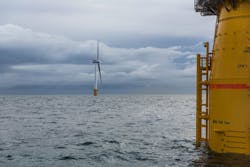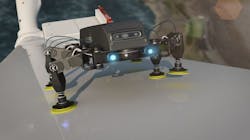Majors supporting UK floating offshore wind center
Offshore staff
GLASGOW, UK – Ten organizations, including Equinor, Shell and Total, have joined the Offshore Renewable Energy (ORE) Catapult’s national Floating Offshore Wind Centre of Excellence (FOWCoE).
The other new participants are offshore wind developers EDF Renewables, EDP Renewables, ESB, Mainstream Renewable Power, ScottishPower Renewables, SSE Renewables, and Offshore Wind Power Ltd., a joint venture between the Green Investment Group and RIDG.
FOWCoE will focus on all areas of floating wind activity in the UK with four principal work streams: technology development, supply chain and operations, development and consent, and delivering net zero.
The goal is to cut the cost of energy from floating wind, speed up development of floating farms, create opportunities for the UK’s supply chain, and support innovations in manufacturing, installation and operations and maintenance.
The Centre plans to collaborate with the Welsh and Scottish governments and regional authorities in England, UK academic institutions, and technology/supply chain providers.
Initial projects will focus on the development and consenting process for floating offshore wind; project and technology certification; classification and application of standards; devising a cost-reduction pathway to commercial competitiveness; and defining the energy systems benefits of floating offshore wind.
ORE has also provided an update on the two-year MIMRee (Multi-Platform Inspection, Maintenance and Repair in Extreme Environments) robotics project, which has a £4.2-million ($5.2-million) grant from Innovate UK.
MIMRee is autonomous system capable of planning its own operational missions to offshore wind farms. A mothership will scan moving turbine blades on approach, then launch teams of inspection drones carrying blade crawlers to inspect and repair damaged blades.
The Thales imaging system is said to have delivered blur-free images of moving wind turbine blades at ORE Catapult’s Levenmouth Demonstration Turbine off the coast of Fife, eastern Scotland. The goal is to be able to scan blades for defects, without the need to stop turbines for several days.
MIMRee mission planning software developed by Professor Sara Bernardini of Royal Holloway University of London has been integrated with the Thales vessel and inspection drones developed by a team from Manchester and Bristol Universities.
The drones have successfully been used for launch, recovery, and navigation from the vessel.
Another aim of the project is to demonstrate an integrated inspect-and-repair system for wind turbine blades, using the BladeBUG robot, which recently demonstrated its walking abilities on various blade surfaces at ORE Catapult’s National Renewable Energy Centre.
Recent milestones include development of an autonomous repair arm at the Royal College of Art Robotics Laboratory. This can switch quickly between modules for cleaning, sanding and top-coating damaged areas of blades, providing real-time feedback visualisation.
Plant Integrity has produced the blade crawler’s non-destructive testing payload following experiments with visible and short-wave infrared image capturing the module employs a machine-learning algorithm and a scanner for exact measurement of defects under varying ambient light conditions.
Wootszkin, an electronic ‘skin’ patented by robotics company Wootzano will allow the robot to feel the surface of the blade and to determine the surface conditions of the blade, helping the robot to walk in an extreme environment.
06/25/2020

